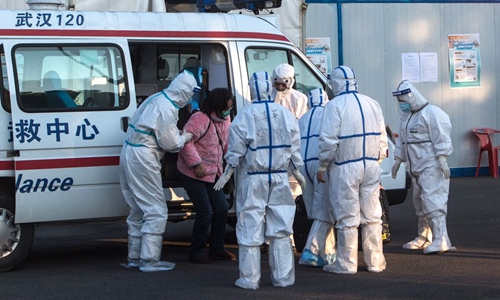HOME >> CHINA
Over 100 infections by end of 2019, major outbreak from mid to late January: CDC
Source:Globaltimes.cn Published: 2020/2/19 0:55:34

Medical staff receive a patient infected with the novel coronavirus at the temporary hospital converted from Wuhan Sports Center in Wuhan, central China's Hubei Province, Feb. 12, 2020. (Xinhua/Xiao Yijiu)
It's highly likely that there were 104 patients infected with #COVID-19 in the epicenter of Wuhan, capital city of Central China's Hubei Province, before December 31, 2019, and the number of infections surged rapidly in mid-January, according to the latest Chinese CDC research paper.
The paper did a retrospective investigation of 44,672 confirmed patients and divided the outbreak of the deadly disease, which has so far caused 72,436 infections nationwide, into five different phases, including the one before December 31, 2019, January 1 to 10, January 11 to 20, January 21 to 31 and February 1 to 11.
The paper found that it's possible that there were 104 infected patients before December 31, 2019, while the full-scale outbreak occurred in the last 10 days of January, with 26,468 new infections.
From January 11 to 20, there were 5,417 new infections in total, which was also in line with information provided by local hospitals in Wuhan to the Global Times, indicating that even before Zhong Nanshan, a top medical advisor warned the disease could be transmitted human to human on January 20, many hospitals in Wuhan had received a large number of patients with fever from unknown causes.
However, those concerns remained at the local hospital level, with no further prevention and control measures taken by local authorities.
Open records show that from December 31 to January 17, the local health authority neither reported the fact that the disease could be transmitted human-to-human nor the number of new infections. That's despite efforts by local doctors like Li Wenliang, who is also considered to be the "whistleblower," disclosed the information of a SARS-like disease occurring in the city in late December, trying to alert people about the seriousness of the matter.
Two days after Zhong announced human-to-human transmission of COVID-19, Hubei launched an emergency and level-II response to a public health incident, sparking an outpouring of criticism of local authorities for delaying an effective response mechanism, which caused a lag in the treatment of patients.
Another major takeaway from this research paper is analysis of the infection of 1,688 medical staff. At the beginning of January, medical staff were being infected with coronavirus, but the situation was not considered severe. However, from mid-January, the number surged and grew to its peak in the last 10 days of the month.
The research paper said the virus had been transmitted to medical staff at hospitals, but there was no evidence that a 'super-spreader' incident had occurred.
Hubei has a relatively high mortality rate compared to other regions, as its rate is 7.3 times higher than the rate outside the province due to the ineffective implementation of prevention and control measures, and in some cases a slow response time, according to the paper.
Outside Hubei, the mortality rate of COVID-19 is 0.4 percent while the province is at 2.9 percent.
Global Times
Posted in: SOCIETY